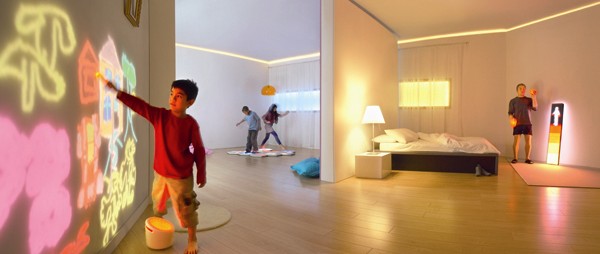KINETICS BY PHILIPS
Como será a sua casa em 2013? Em uma época em que a tecnologia evolui mais rápido que a vida útil de um iPod, responder a esta pergunta pode ser um tanto complicado. Mas algumas pistas do que está por vir estão espalhadas nas tendas brancas sob a recém-construída – e moderníssima – ponte estaiada da marginal do rio Pinheiros, em São Paulo. Na mostra The Simplicity Event, evento da Philips que já passou pela Holanda, Inglaterra, Estados Unidos e China, cinco ambientes exibem os protótipos e produtos-conceito que a fabricante de eletroeletrônicos holandesa espera que você use daqui a cinco anos de uma forma tão natural quanto é usar hoje um rádio de pilhas. Em comum, todos tentam aliar tecnologia a um belo design para atender de forma simples os desejos de consumidores de todo o mundo.
Cada espaço da mostra é dedicado a um tema. No Ouça o seu corpo, a idéia é prevenir o que será mais difícil e caro de remediar depois com aparelhos que promovem uma vida mais saudável. Luz e sons também ajudam nesta tarefa, como ajudam a entender as estações Cuide do seu corpo e Relaxe a Mente. Nelas, aparelhos usam freqüências de luz para despertar, relaxar e energizar seus usuários, enquanto outros tornam os ambientes da casa mais confortáveis e divertidos.
“Nada de inércia” é o lema do espaço Mexa o seu corpo, em que pisos interativos e paredes luminosas entretêm as crianças enquanto seus pais se exercitam com um personal-trainer virtual. E, na era da hiperconectividade, não poderiam faltar os aparelhos mostrados na estação Compartilhe Experiências, como o porta-retrato digital que envia e recebe fotos e uma tela sensível ao toque criada para enviar e receber mensagens de texto e vídeo. “Nem todos estes produtos irão para o mercado”, diz Stefano Marzano, diretor mundial de design. “Nossos testes mostram que alguns atendem a um público mais amplo, e são estes que levaremos à frente”.
Aparelhos com funcionamentos e formas tão diferentes têm todos um mesmo conceito por trás: usar a tecnologia para criar um estilo de vida mais harmonioso. Desde 2004, este tem sido o lema – e a estratégia de negócios – da Philips. Isso significa inverter o paradigma da tecnologia pela tecnologia em nome de uma abordagem mais humanizada com tecnologias sintonizadas com as necessidades de pessoas comuns. “Não somos mais uma empresa orientada para tecnologia, mas para o consumidor”, diz Geert van Kuyck, diretor mundial de marketing da companhia.
Esse foco diferenciado está dando certo para a empresa. Avaliada em US$ 7 bilhões, a Royal Philips Electronics já ocupa a 42ª posição no ranking internacional de marcas mais valiosas do mundo elaborado pela consultoria Interbrands. A empresa foi eleita a 38ª mais inovadora pela revista Business Week em 2007. “Nos últimos cem anos, as empresas se esforçaram para criar a próxima grande onda e todos seguiam atrás”, diz van Kuyck. “Nos próximos cem, será muito mais importante entender primeiro os problemas dos consumidores para só então trazer soluções na forma de produtos”.
Confira abaixo uma galeria com os principais destaques de cada estação da mostra:

PINTANDO O SETE: com Drag & Draw, pintar a parede é permitido. As crianças escolhem as cores no balde eletrônico, que projeta na parede os traços feitos com uma caneta especial. Depois, elas podem adicionar som e movimento aos desenhos


CONFORTO: Na sala de estar do futuro, o conforto não vem só do sofá. Luzes coloridas e sombras são projetadas para gerar sensações e complementar o clima criado com o sistema de som moderno (sobre a prateleira) que mais parece uma obra de arte

ESPELHO, ESPELHO MEU: o InForm avalia o peso, gordura e hidratação do corpo do usuário e mostra os resultados e até dá informações sobre o período fértil feminino por meio de uma tela que parece um espelho quando desligada

RELAXE: o Soft Therapy reduz a tensão muscular com uma combinação de calor, massagem vibratória e raios infravermelhos. Como o colete não tem fios, pode ser usado enquanto se anda dentro de casa. E é tão fino que dá para colocá-lo embaixo da roupa

VOCÊ TEM UMA MENSAGEM: o InTouch é a versão moderna do quadro de recados. Com a sua tela sensível ao toque, dá para escrever nele com uma caneta especial e enviar recados via internet para os amigos. Também permite gravar mensagens de vídeo
Share this:https://adrianasassoon.wordpress.com






















